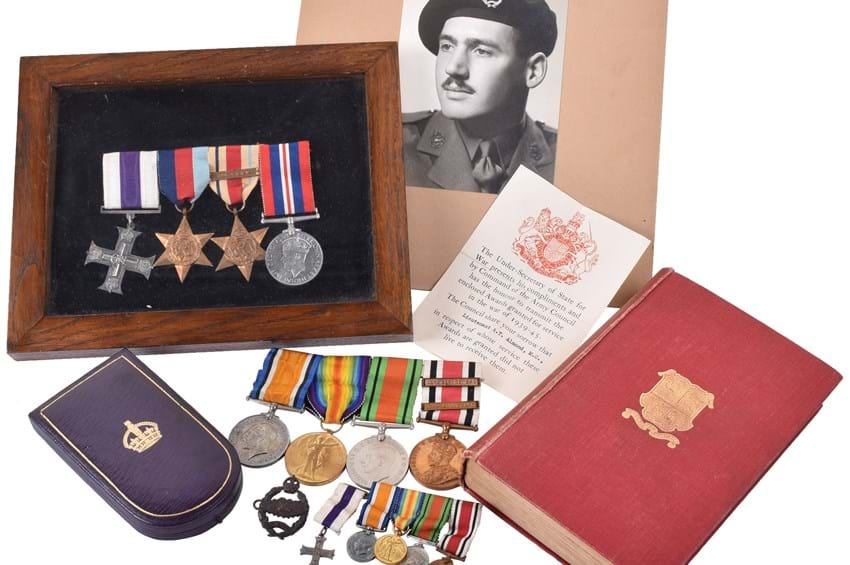A gallant officer at the battle of El Alamein during WW2
17/01/2020 | Matthew Tredwen

Arthur Thomas Almond was born in 1914, in Cambridgeshire. Educated at Bishop Stortford College. He served with the Royal Tank Regiment, gaining a commission in the 46th (Liverpool Welsh) Battalion of the RTR. He served with the battalion in North Africa and was awarded the Military Cross in 1942, appearing in the London Gazette 5th November 1942. The recommendation for the immediate M.C was as follows:
“At about 0900 hrs on 4 Sep 42, 2/Lt Almond’s troop was ordered forward on to an exposed position subject to a lot of enemy arty fire. 2/Lt Almond’s tank received a direct hit from a large calibre gun. The tank which was moving at about 10 m.p.h, caught fire and ammunition exploded. 2/Lt Almond and his gunner climbed out onto the turret of the tank but did not leave the tank until they extricated the driver. 2/Lt Almond, although ordered to evacuate his crew, returned on another tank and managed to put out the fire sufficiently to get into the driver’s seat. He then started the engine and, although burnt himself, managed to tow out another tank which had been hit. He then drove his tank back, collected his crew and then returned into action after getting the tank into fighting trim. In spite of his burns and a temporarily blinded eye, he remained in action for another 10 hrs under almost continuous shell fire. The determination, bravery and coolness under fire which this officer showed proved a fine example to the remainder of his troop and the fact that they remained in their position materially assisted the success of the action on this front.”
The 46th (Liverpool Welsh) Bn Royal Tank Regiment were part of the 23rd Armoured Brigade. They served in North Africa using the unreliable Valentine tanks. They fought gallantly during the first and second battles of El Alamein. Lieutenant A T Almond was killed in action on 28th October 1942. On the night of 28th / 29th October the 9th Australian Division put in another set-piece attack. 46th RTR supported 26th Australian Brigade, with some of the infantry riding into battle on the Valentines. But the darkness, dust, and scattered mines frustrated the attempt to rush the enemy position. The tanks came under anti-tank and machine-gun fire, forcing the infantry to dismount and lose touch with the tanks. There was confused fighting, after which the infantry dug in, supported by the seven Valentines of 46th RTR that were still running, the regiment's casualties that night were 15 tanks knocked out, and many more damaged, but all were later recovered. Although the attack had fallen short of its ambitious objectives, it had punched a hole between the German 21st Panzer Division and the German Wehrmacht 90th Light Division, effectively destroying II Bn of 125th Panzer Grenadier Regiment and a battalion of Italian Bersaglieri troops.
An extract from the publication Valentine in North Africa 1942-43 gives the following information, “El Alamein, 46th RTR by now were also working with the Australians, and during the main Australian thrust on the night of October 28/29 were to attack with 2/23rd Battalion and secure the road. Unfortunately, things began to go wrong from the start. The final briefing was held very late, and Col Clarke returned without sufficient time to give his Squadron Leaders anything more than the barest details. The attack was to get under way almost immediately, and would be delivered from a start-line which had been chosen from the map, and which had not been reconnoitred. Some of the infantry would ride on the tanks, and others in carriers. The start-line was in fact, in the middle of a minefield, and on the way to it the regiments were subjected to heavy fire which caused the infantry to drop off. Several tanks missed the minefield gaps and became casualties. The situation became extremely confused, and the enemy fire rose to a crescendo. In the light of three or four burning Valentines the anti-tank gunners were able to pick off their victims from three sides at ranges up to 1,000 yards. The attack broke down into un-coordinated assaults which took a heavy toll of both tanks and infantry. Col Clarke and his Intelligence Officer were badly wounded by a mortar shell, and the Regiment was taken over by Major Offord. After a night of savage fighting, Col Evans of 2/23rd finally ordered his battalion to dig in at 04.00, 1,000 yards in advance of the original start line, The 2/23rd had lost 29 killed, 172 wounded and 6 missing. 46th RTR had lost all but eight of their tanks and had a high percentage of their crews killed or wounded, including all the Squadron Commanders. The casualties sustained by the 46th and 2/23rd Battalion had not been in vain. After the battle, Rommel recorded that the British tanks and infantry had succeeded in blowing a gap in his line, cutting off the 2nd Bn 125 Panzer Grenadier Regiment and a Battalion of XIth Bansagliari, who remained in Thompson’s Post, almost surrounded by their assailants, resisting all attempts to dislodge them with a ferocious determination. In addition, the 125th Regiments 3rd Bn had virtually ceased to exist by next morning, the battle having raged with tremendous fury for six hours”.
Lieutenant Arthur Thomas Almond is buried at the El Alamein war cemetery, Egypt. He was 28 when he was killed. He is also commemorated on memorials in his home town of Cambridge.

